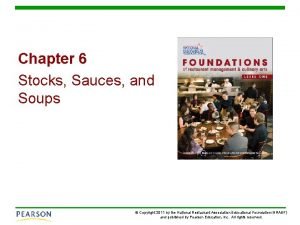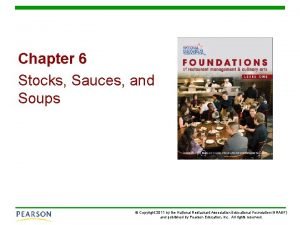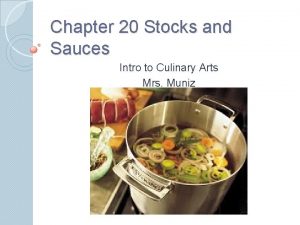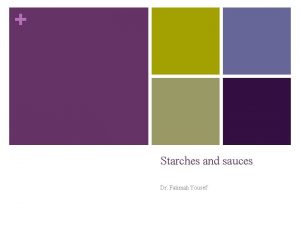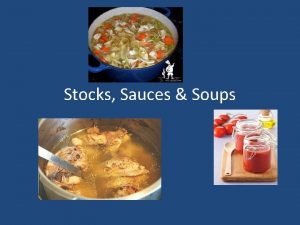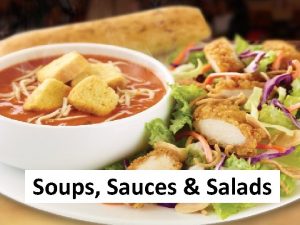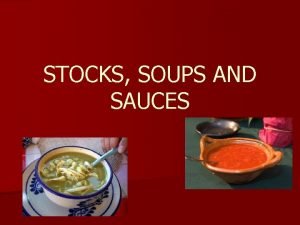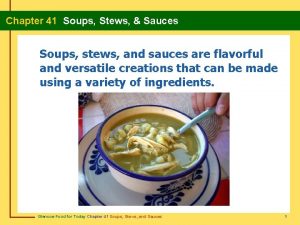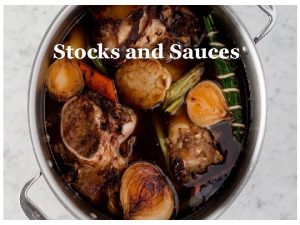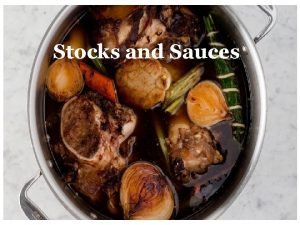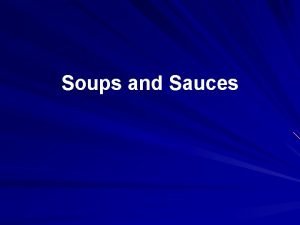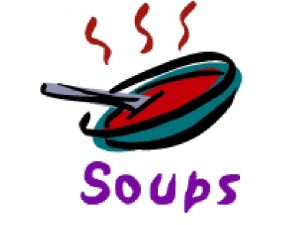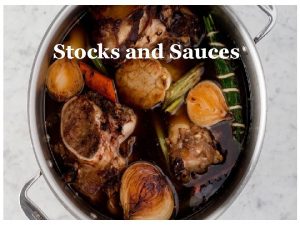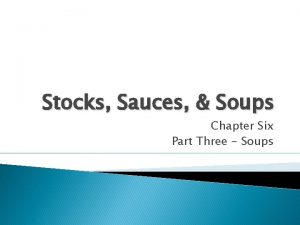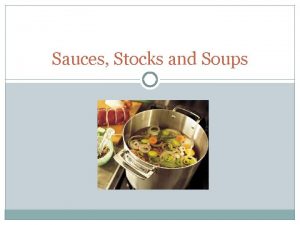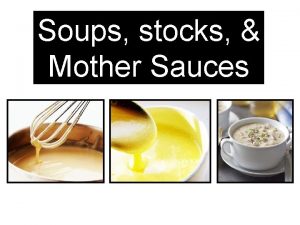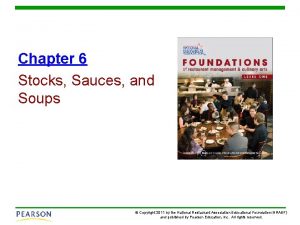Chapter 6 Stocks Sauces and Soups Copyright 2011














- Slides: 14

Chapter 6 Stocks, Sauces, and Soups © Copyright 2011 by the National Restaurant Association Educational Foundation (NRAEF) and published by Pearson Education, Inc. All rights reserved.

The Essential Parts of Stock § There are four essential parts to all stocks: § 1. § 2. § 3. § 4. § Mirepoix: refers to the mixture of coarsely chopped ____(50%) ______(25%) and ______ (25%) that provide a flavor base for stock. § Aromatics: such as bouquet garni and sachet d’épices, are the ………………………………. . 6. 1 Chapter 6 | Stocks, Sauces, and Soups 2

Types of Stocks A stock is a …………………. § To use bones for stock, you must first ____ them to the right size and then prepare them by _____, or ______. 6. 1 Chapter 6 | Stocks, Sauces, and Soups 3

Types of stocks § _____stock: clear, pale liquid § _______ stock: amber colored; uses browned bones § Fumet: made with _______ bones § Court bouillon: made with ________ § ______: reduced stock with jelly-like consistency § Jus: ________________ § Vegetable stock: made with ___________________

Preparing Stocks § _______: rids them of some of the impurities that can cause cloudiness in a stock. § To _______ bones, roast them in a (400°F) oven for about an hour, until they are golden brown. § _____ causes bone and mirepoix to release flavor more quickly when liquid is added. § _____ stock to minimize the time the stock spends in the temperature danger zone (cool in an ice water bath) § Frozen stocks can be held for ____ months 6. 1 Chapter 6 | Stocks, Sauces, and Soups 5

Degreasing Stock Degreasing: process of removing fat ……………………………. . § Degreasing also removes some of the fat content, making the stock more _______. § Degrease stock by ___________ hard fat. 6. 1 Chapter 6 | Stocks, Sauces, and Soups 6

Grand Sauces A _____ is a liquid or semisolid product that is used in preparing other foods. § There are ______classical grand sauces that are the basis for most other sauces: § _________ milk and white roux § __________ brown stock and brown roux § ___________ stock and tomatoes § _______ an emulsion made from eggs, butter, and lemon. § _______ veal, chicken, or fish stock and a white roux ______ are rarely used by themselves 6. 2 Chapter 6 | Stocks, Sauces, and Soups 7

Derivative sauces § __________: equal parts espagnole sauce and veal stock § _______sauce: tomato sauce , onions, garlic, parsley § ______________: Hollandaise, Tarragon, white wine, vinegar

Basic Ingredients in Sauces A key ingredient in sauce is the _______, which adds richness and body. § ______: a thickener made of equal parts cooked flour and a fat (clarified butter, oil, or shortening) § Beurre manié: thickener made of equal parts ……………………… § _______: cornstarch mixed with a cold liquid, can be used instead of roux. § _______: mixture of egg yolks and heavy cream, often used to finish some sauces. 6. 2 Chapter 6 | Stocks, Sauces, and Soups 9

Preparing Different Kinds of Sauces § ___________: mixture of butter and various flavoring ingredients (herbs, nuts, citrus zest, shallots, and vegetables) § _______: thick puréed sauce. § _______: cold mixture of fresh herbs, spices, fruits, and/ or vegetables. § _______: sauce made from the juices from cooked meat and brown stock. § Straining methods: 1. _______ method (with cheesecloth) 2. China cap or ______ 6. 2 Chapter 6 | Stocks, Sauces, and Soups 10

Basic Kinds of Soup There are two basic kinds of soup—clear soups and thick soups. § Clear soups include: 1. __________ (water, vegetables, bones, mirepoix, bouquet garni) 2. consommés (rich, flavorful stock that is ________) 3. 4. 6. 3 Chapter 6 | Stocks, Sauces, and Soups 11

Thick soups § Thick soups include: 1. cream soups: _____________ 2. purée soups: thickened by the _______ found in the pureed main ingredient (potatoes) 3. bisques: _______ shells and vegetables then strained resulting in grainy texture 4. chowders: hearty thick soup; thickened with _______

Basic soups § There are many variations of these basic soups: § Fruit soups: _______, a savory tomato soup § Cold soups: ____________ § Traditional regional soups: • 1. • 2. • 3.

Preparing Soups § Most soups are cooked at a _______simmer and stirred occasionally. § Soups should also be ______ just before service. 6. 3 Chapter 6 | Stocks, Sauces, and Soups 14
 Chapter 6 stocks sauces and soups
Chapter 6 stocks sauces and soups Chapter 6 stocks sauces and soups
Chapter 6 stocks sauces and soups Chapter 6 stocks sauces and soups
Chapter 6 stocks sauces and soups Chapter 6 stocks sauces and soups
Chapter 6 stocks sauces and soups Chapter 6 stocks sauces and soups
Chapter 6 stocks sauces and soups What is starch
What is starch The liquid that forms the foundation of sauces and soups
The liquid that forms the foundation of sauces and soups Mother sauce name
Mother sauce name Essential parts of stock
Essential parts of stock What do soups, stews, and sauces have in common?
What do soups, stews, and sauces have in common? Different stocks and sauces
Different stocks and sauces Stocks and sauces
Stocks and sauces Classification of thickening agents
Classification of thickening agents Classification of soup
Classification of soup Chapter 11 stocks
Chapter 11 stocks

